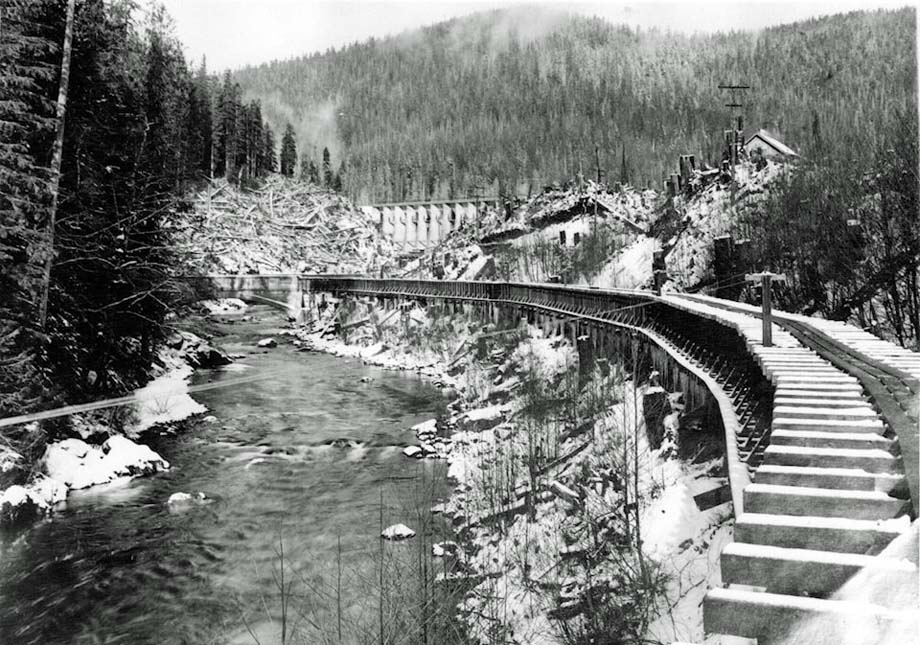At the time of this photo in the late 1920s, the Vancouver Island Power Company had just finished rebuilding the flume that carried water from Diversion Dam, seen in the background, to the Fore Bay Reservoir, where steel penstocks forced the water into the turbines in the powerhouse.
 There are two existing photographs of the flume near the Diversion Dam. This one shows the flume crossing over to the west (left) side of the river but an earlier photo shows the flume lying on the east side of the river during dam construction. An undated photo taken about the same time shows two flumes at the Diversion Dam, one on each side of the river.
There are two existing photographs of the flume near the Diversion Dam. This one shows the flume crossing over to the west (left) side of the river but an earlier photo shows the flume lying on the east side of the river during dam construction. An undated photo taken about the same time shows two flumes at the Diversion Dam, one on each side of the river.The work, which took place in the Jordan River watershed to produce hydro electric power and transmit it to serve Victoria, was begun in 1909, and when the Diversion Dam was completed in 1912, the project was heralded as a major engineering achievement.
The flume shown in the foreground was eight feet wide and six feet deep, built of Douglas-fir, with components of cedar and spruce.
This replaced the original flume, winding five-and-a-half miles down the hillside, originally six feet wide and four feet deep, built of cedar.
We are told that the water took 75 minutes to travel from the dam to Fore Bay.
The Diversion Dam is located about seven miles upstream from the river mouth, a reinforced-concrete structure, 900 feet long and 126 feet in height.
In more recent decades, particularly in the 1980s, the Sooke Region Museum was approached by BC Hydro engineers for historic photographs which they would use to determine reinforcements they would install in view of the danger of earthquake disturbance.
Residents will recall that more recently still, BC Hydro determined that potential hazards required major changes in residential use of the river mouth area.
Ted Banner Sr. and his son Cliff were among well-known names connected to the operations of the entire hydro electric system.
For a time, tours on a narrow gauge railway were made available in order for passengers to view the spectacular development in the gorge.
In the 1960s, considerable repair work was undertaken on the flume itself, and some of our senior folk who were young guys back then got work there, among them Hilliard Lewis, Bobby and Jimmy Nelson, Stu Soderberg, Evan Haldane, and Ross Pitre.
By 1971, however, the flume, penstocks, and Fore Bay had been replaced by a steel tunnel, single penstock, and a lower dam added, called the Elliott Dam for longtime superintendent Jack Elliott.
A new powerhouse on the west side of the river had replaced the historic original powerhouse structure which still stands today, though overgrown now as the rainforest reclaims its own.
Elida Peers.
(likely no image with original article)
(usually because it's been seen before)
provisions in Section 29 of the
Canadian Copyright Modernization Act.


